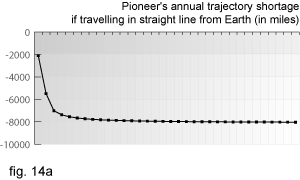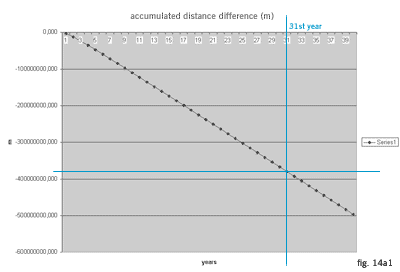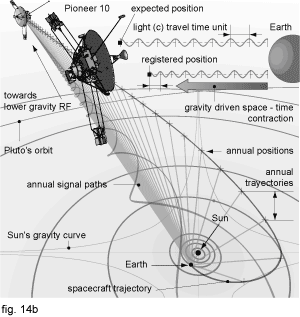
pioneer's mystery solved
Part of this paper is pasted from Perception theory aricle to keep the whole Pioneer's study in one place.
A good example of wrong measurements caused by using our RF layer constant speed of light is Pioneer's anomaly which has been known as Pioneer's mystery for almost twenty years. For about 30 years, as they've made their ways to the edge of the Solar system, the two Pioneer spacecrafts (10 and 11) were tracked with enormous accuracy - to one part in a trillion. After scientists analyzed the tracking data with the most sophisticated statistical and computer algorithms, taking into account all the known forces that can affect these spacecrafts, there was still a deviation from Pioneer’s predicted motion.
Both spacecrafts were slightly blue shifted and their position in space didn't match to where they were supposed to be. They seemed to be slowing down for about 8000 miles per year from their predicted motion. It isn't much if one considers their travelling speed of about 12200 m per second. But in the last thirty years it accumulated to a distance almost equivalent to that from Earth to Moon. Scientists have being forced to consider the unthinkable: something may have been wrong with their understanding of The Laws of Physics. NASA's Jet Propulsion Laboratory scientists have been searching for an explanation since 1980. But as of yet, they have found nothing conclusive.
Being twice as far from Sun as Pluto, Pioneer 10 is travelling further and further from Sun’s gravity influence (which is 99% of solar systems mass). We use Schwarzchild formula to calculate gravitational time dilation for each annual travel region. Each region is 384.739.200.000 meters which is the distance Pioneer should travel in one Earth’s year time. We convert that distance in light seconds (the time it takes light to travel that distance) which is 1.283,351831352600000 seconds. Calculating Pioneers speed and direction we will take its predicted position for 33rd year of travel. Converting that position in light seconds one comes up with 39.783,906771930600000 seconds which makes about 11,051 hours. If the speed of light is considered to be constant, that would be the travelling time for our signal to make one way contact with the spacecraft. Since signal is travelling through different RF layers, when dilations from different travelling regions are counted together, predicted time for signal travel would be dilated to 39.783,906278418500000 seconds (fig. 10).
To get a value for annual negative acceleration we should first subtract dilated with non dilated signal. The result, -0,000493512052344 seconds, is the time for which expected signal was overtaken in one way communication. Since for determining spacecraft's position in space RTLT is used (Round trip light time, which is in fact definition offered from Einstein for clock synchronization by light signals), we multiply it by two (the signal should travel there and back). We subtract the result (- 0,000987024104688 s) with the number we got by using the same procedure of calculation for previous year which is in our case - 0,000953438138822 s (and we are interested in annual data). This result of negative time is multiplied with the distance Pioneer should travel in one year time (384.739.200.000 m). The result is the Pioneer's annual trajectory shortage and equals - 12.921.837,6385979 meters (- 8.029,24160087789 miles) (fig. 14a). When we make a sum of these annual values the result for 31 year would be -379.746.864,417969 meters. Average distance between Earth an Moon is 384.400.000 meters (fig. 14a1).


To determine the exact distance of spacecraft in deep space measured with our RF speed of light, we end up with a simple equation;
![]()
where s is a distance expressed in our RF units, se is expected distance, td is dilated time, and 2 is for Round trip light time.
Since td=cd=sd, it is the same if we write;
![]()
or
![]()
From equations above, it is obvious that less intense gravitational fields would slow down the spacecraft, relatively to our RF, and vice versa.
What does this prove?
The Pioneer's RF accelerated and, to compensate for perception, its speed of light decreased proportionally. Because of that, the spacecraft time experience didn't change.
If we take velocity formula v=s/t and consider same value gravity driven meter (s) and second (t) contraction, velocity (v) for each RF, which is in our case c, wouldn’t change. But since the (t) and (s) unit values would differ from our RF, c unit would be different correspondingly.
Pioneer's distance from the Earth was measured by a signal travelling at, as considered wrong, the constant speed of light. While Pioneer's meter and second became shorter, the light seconds got shorter proportionally. In other words, in one second of our time, light travelled shorter way. Seeing from our RF layer, the light was slowing down. Because of travelling shorter way, the signal with a time code we sent to Pioneer came back a little bit to early. By calculating time it spend travelling, with Earth’s "physical constant" speed of light, and knowing its travelling speed, it is obvious that the result would lead to a conclusion that Pioneer is slowing down (fig. 14b). Pioneer’s tracking data is actually a function of its meter, time and light speed contraction driven by gravity.

It also proves that light energy and speed, relatively to our RF, is decreasing with the decrease of gravitation. Correspondingly, it increases when closer to more intense gravitational fields. It corrects a mistake in General theory of relativity saying that the energy of light is falling down while trying to leave gravitational source. That presumption led to a wrong interpretation of red shift phenomenon. The result was a domino effect which produced numerous of other misinterpretations.
